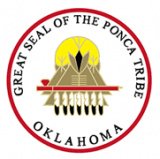Ponca people are thought to have migrated to the Great Plains from the Ohio River valley. In the mid-16th century, Ponca people migrated with the Kansa, Omaha, and Osage north, up the Mississippi. They separated from the Omaha in the mid-17th century but reunited with them near the Niobrara River of Nebraska in 1793. First exposed to European disease through trappers, by the time the Lewis and Clark Expedition arrived in their lands in 1804, almost 90 percent of their orignal population had died off.
The Ponca signed their first treaty with the United States in 1817, ceding two million acres of their lands. In 1858, their reservation had been reduced to 100,000 acres. Poncas were removed to Indian Territory; however, 25% of the tribe died from disease and starvation in a single year. Chief Standing Bear led a group on a 500-mile walking trek back to their homelands in Nebraska to bury their dead. The subsequent trial, Standing Bear v. Crook established the writ of habeas corpus for the first time for Native Americans, also allowed the Poncas to have lands restored to them in Nebraska. Niobrara Island was included in the original reservation.
In the 1930s, an archeological survey was begun on the Ponca/Niobrara Reservation south of the Niobrara River and Lynch, Nebraska. In an effort to identify and save prehistoric artifacts before they were destroyed during agricultural development, the University of Nebraska and the Smithsonian Institution undertook a joint project. The team excavated a prehistoric Ponca village; the ten laborers on the project were paid by the Works Progress Administration of the Franklin D. Roosevelt administration during the Great Depression. The project was to survey, identify and protect ancient resources. The Ponca village included large circular homes up to sixty feet in diameter; their residences were located for almost two miles along the south bank of the Niobrara River.
In the 1950s, the United States government unilaterally terminated recognition of the Ponca Tribe of Nebraska. Since 1990, the tribe reacquired 413 acres of their lost lands. The US government finally re-recognized the tribe in 1990.
